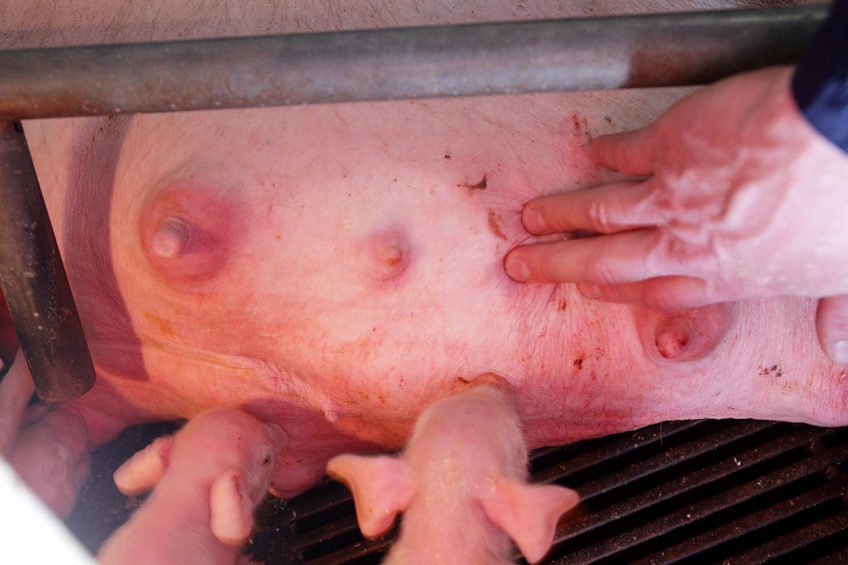All about sows, udders and MMA (part 2)

How do normal udders feel? Perhaps a simple question and perhaps the answers are well-known. Now what to do when an sow’s udder does not feel normal and what can be done about it? Pig management expert John Gadd presents an overview.
Agalactia is the ceasing of milk production, while hypogalactia is a noticeable reduction in milk supply. Agalactia is quickly noticeable of course, while hypogalactia is more insidious as it becomes more obvious as the piglets get hungrier and hungrier and the less advantaged weaken into lassitude.
Get to know your udders!
Stockpersons should familiarise themselves with the sow’s udder. A good farrowing attendant is always judiciously, i.e. quietly, stroking the cisterns for signs of excessive heat, looking for redness, and palpating (the veterinarian’s term for ‘feeling’ them by touching).
Talk to the sow as you do it and they will come to enjoy it as a form of stress-relief – as in a massage parlour!

In an earlier Expert Opinion, John Gadd introduced the topic of MMA
A normal udder is quite soft and the subsurface should ‘give’ on firm pressure from the palm of the hand used with a slight sideways movement. The healthy sow will not object to this pressure or shift her stance.
How to palpate an udder?
So why do it? Firstly to pick up any abnormalities such as lumps or knots – the presence of infection leading to mastitis. The cistern should feel ‘smooth’ to gentle pressure and if a slight trend toward a ‘granular’ feeling underneath, this could be an early sign of developing infection, which prompt treatment could well nip the infection in the bud – an early sign of mastitis. If any swelling is apparent, then inflammatory drugs should be given.
Palpation
Start palpating the udder as soon as the sow has farrowed. This is done by placing a teat in the palm of the hand, the index finger between the two parts of the udder and the thumb to the outside, thus it is possible in this arrangement to pick up the udder and deeply palpate it. You need to be quite firm but gentle.
The normal udder should be quite soft whereas the diseased gland will show varying degrees of hardness and unevenness leading to a knobbly feeling. It is important to select a gland which you know to be normal and apply sufficient gradual pressure until the sow notices it. This same pressure should be applied to all other glands and the abnormal ones will be detected.
Are one or more glands infected? Are they hard and painful? If so, then a stockperson can pick up these signs early on, which is why I always made time to palpate twice a day for 3 days after farrowing.

Read more Expert Opinions in our special section at Pig Progress
The ‘proof of the pudding’
Make time to do it. Attendants generally do not spend enough time like this with their sows. Several surveys, including mine suggest that only 2.5 man-hours per sow per year are spent with the farrowed sow and her litter, when treble this is needed.
Those who afforded this extra time got only 1% MMA of all types, had one more piglet weaned per litter, udder problems reduced by 20% and returns to service lowered by 15%.
Udder oedema
Non-infectious causes are likely to result in a poorly-developed udder with fluid present, which can then be confirmed by a firm pressure by a finger which picks up hollows filled with fluid. Get your veterinarian to teach you the feel of this.

Do sows always get the right feed for providing milk to 30+ piglets? Dr Heinrich Kleine Klausing addressed this issue in an insightful contribution
Engorged udder
An overall hardness rather than a knotty feeling could be an engorged udder noticed in the first few days from farrowing, caused by overfeeding shortly before it. An engorged udder is painful and the sow will tell you so.
Fatty udder
Some of the genetically-lean pigs of today, especially in parities 1 and 2, can have too much fat in the udder caused by feeding too much energy before farrowing. This again gives a different feel. Sometimes described as ‘slipping jelly’ to the udder when palpated.
Finally – it is always a good idea to have a pig vet demonstrate these sensations to you.
 Beheer
Beheer








 WP Admin
WP Admin  Bewerk bericht
Bewerk bericht